

Policy Gradients CS 285 Instructor: Sergey Levine UC Berkeley
The goal of reinforcement learning we’ll come back to partially observed later
The goal of reinforcement learning infinite horizon case finite horizon case
Evaluating the objective
Direct policy differentiation a convenient identity
Direct policy differentiation
Evaluating the policy gradient fit a model to estimate return generate samples (i.e. run the policy) improve the policy
Understanding Policy Gradients
Evaluating the policy gradient
Comparison to maximum likelihood supervised training learning data
Example: Gaussian policies
What did we just do? good stuff is made more likely bad stuff is made less likely simply formalizes the notion of “trial and error”!
Partial observability
What is wrong with the policy gradient? high variance
Review • Evaluating the RL objective • Generate samples fit a model to • Evaluating the policy gradient estimate return • Log-gradient trick generate • Generate samples samples (i.e. run the policy) • Understanding the policy gradient improve the • Formalization of trial-and-error policy • Partial observability • Works just fine • What is wrong with policy gradient?
Reducing Variance
Reducing variance “reward to go”
a convenient identity Baselines but… are we allowed to do that?? subtracting a baseline is unbiased in expectation! average reward is not the best baseline, but it’s pretty good!
Analyzing variance This is just expected reward, but weighted by gradient magnitudes!
Review • The high variance of policy gradient fit a model to • Exploiting causality estimate return • Future doesn’t affect the past generate samples (i.e. • Baselines run the policy) • Unbiased! improve the policy • Analyzing variance • Can derive optimal baselines
Off-Policy Policy Gradients
Policy gradient is on-policy • Neural networks change only a little bit with each gradient step • On-policy learning can be extremely inefficient!
Off-policy learning & importance sampling importance sampling
Deriving the policy gradient with IS a convenient identity
The off-policy policy gradient if we ignore this, we get a policy iteration algorithm (more on this in a later lecture)
A first-order approximation for IS (preview) We’ll see why this is reasonable later in the course!
Implementing Policy Gradients
Policy gradient with automatic differentiation
Policy gradient with automatic differentiation Pseudocode example (with discrete actions): Maximum likelihood: # Given: # actions - (N*T) x Da tensor of actions # states - (N*T) x Ds tensor of states # Build the graph: logits = policy.predictions(states) # This should return (N*T) x Da tensor of action logits negative_likelihoods = tf.nn.softmax_cross_entropy_with_logits(labels=actions, logits=logits) loss = tf.reduce_mean(negative_likelihoods) gradients = loss.gradients(loss, variables)
Policy gradient with automatic differentiation Pseudocode example (with discrete actions): Policy gradient: # Given: # actions - (N*T) x Da tensor of actions # states - (N*T) x Ds tensor of states # q_values – (N*T) x 1 tensor of estimated state-action values # Build the graph: logits = policy.predictions(states) # This should return (N*T) x Da tensor of action logits negative_likelihoods = tf.nn.softmax_cross_entropy_with_logits(labels=actions, logits=logits) weighted_negative_likelihoods = tf.multiply(negative_likelihoods, q_values) loss = tf.reduce_mean(weighted_negative_likelihoods) gradients = loss.gradients(loss, variables) q_values
Policy gradient in practice • Remember that the gradient has high variance • This isn’t the same as supervised learning! • Gradients will be really noisy! • Consider using much larger batches • Tweaking learning rates is very hard • Adaptive step size rules like ADAM can be OK-ish • We’ll learn about policy gradient -specific learning rate adjustment methods later!
Review • Policy gradient is on-policy fit a model to estimate return • Can derive off-policy variant • Use importance sampling generate samples (i.e. • Exponential scaling in T run the policy) • Can ignore state portion improve the (approximation) policy • Can implement with automatic differentiation – need to know what to backpropagate • Practical considerations: batch size, learning rates, optimizers
Advanced Policy Gradients
What else is wrong with the policy gradient? (image from Peters & Schaal 2008) Essentially the same problem as this:
Covariant/natural policy gradient
Covariant/natural policy gradient (figure from Peters & Schaal 2008) see Schulman, L., Moritz, Jordan, Abbeel (2015) Trust region policy optimization
Advanced policy gradient topics • What more is there? • Next time: introduce value functions and Q-functions • Later in the class: more on natural gradient and automatic step size adjustment
Example: policy gradient with importance sampling • Incorporate example demonstrations using importance sampling • Neural network policies Levine, Koltun ‘13
Example: trust region policy optimization • Natural gradient with automatic step adjustment • Discrete and continuous actions • Code available (see Duan et al. ‘16) Schulman, Levine, Moritz, Jordan, Abbeel . ‘15
Policy gradients suggested readings • Classic papers • Williams (1992). Simple statistical gradient-following algorithms for connectionist reinforcement learning: introduces REINFORCE algorithm • Baxter & Bartlett (2001). Infinite-horizon policy-gradient estimation: temporally decomposed policy gradient (not the first paper on this! see actor-critic section later) • Peters & Schaal (2008). Reinforcement learning of motor skills with policy gradients: very accessible overview of optimal baselines and natural gradient • Deep reinforcement learning policy gradient papers • Levine & Koltun (2013). Guided policy search: deep RL with importance sampled policy gradient (unrelated to later discussion of guided policy search) • Schulman, L., Moritz, Jordan, Abbeel (2015). Trust region policy optimization: deep RL with natural policy gradient and adaptive step size • Schulman, Wolski, Dhariwal, Radford, Klimov (2017). Proximal policy optimization algorithms: deep RL with importance sampled policy gradient
Recommend
More recommend